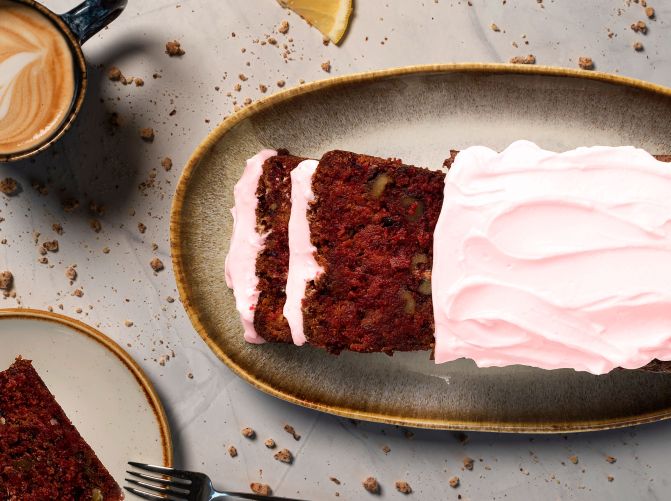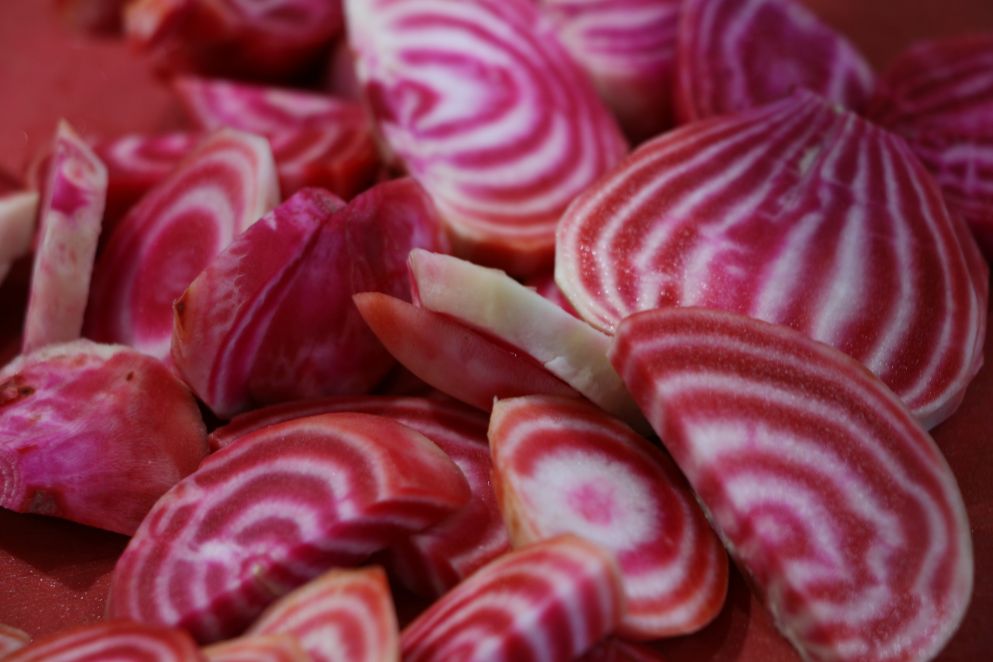Ingredient spotlight: 10 things about beetroot

© Mila/ Unsplash.com
Beetroot is a delicious root vegetable that comes in vibrant colours and has an earthly flavour. With so many recipe options, you may wonder what is the best cooking method? What are the nutritional benefits? How do I pick the right beetroot? Our goal is to share the answers to all these questions and more in this month’s Ingredient Spotlight.
Beetroot is a classic winter vegetable in Europe, that provides us with important nutrients even in the cold season. The new harvest comes onto the market from the end of September and is on sale until spring. You can buy them fresh from the field either loose or in bunches at the weekly market, and in many supermarkets, you can find them pre-cooked and vacuum sealed.
- What are the different beetroot varieties?
Beetroot varieties are distinguishable by their colour. The lighter colours tend to have a milder flavour, than their dark counterparts. Here is a collection of some common types and their attributes.Boro F1/ Red beetroot: very robust, roundish, fresh beet with a deep red colour
Chioggia: colorful, inner rings in white and red; especially pretty in salads.
Albina Verduna: ivory-coloured beet, large fruits and very sweet.
Avalanche: white skin and flesh with clearly visible rings. Mild taste.
Boldor F1: yellowish flesh and orange skin; very mild in taste and sweeter than most red-fleshed varieties.
Crapaudine: good for pickling; lush, pointed and long tubers; white-red inner rings. - Our top recipes: from risotto to cake
If you only think of beet as a salad in a jar, you can get to know this vegetable in a whole new way. Because this delicious vegetable can also be used in many other preparations. Here are some of my favourite beetroot recipes:
Quinoa salad with carrot and beetroot
Risotto with beetroot and goat cheese
Gluten-free beetroot cake with cream cheese frosting
- Know your colour
The plant pigment betanin, which has given beetroot its unmistakable appearance and name, is also found in many other foods. Thanks to its intense colouring power, this ingredient is added as "E 162" to many products like ice cream, desserts, jams and juices, to give them a more intense look. - Where did beetroot originate?
The species Beta vulgaris belongs to the Amaranthaceae family. Their oldest known ancestor, the wild sea beet, was discovered in the Mediterranean. At first, the beetroot greens and leaves were utilized for consumption, and the roots were only used for medicine. According to the History Kitchen, Europeans began cooking the whole crop during the 16th century. - What are the nutritional benefits?
Beetroot is an amazing vegetable to try incorporating into your diet because they are:
> High in immune-boosting vitamin C
> High in fiber
> High in essential minerals like potassium (essential for healthy nerve and muscle function)
> High in manganese (which is good for your bones, liver, kidneys, and pancreas)
> Contain the B vitamin folate, which can help reduce the risk of birth defects.
> They’re great for the liver, as they can stimulate the liver’s detoxifying processes.
> The pigment (betacyanin) in beets is a powerful anti-cancer fighting agent and that paired with the high fiber content of beets help protect against colon cancer. [1]
> Rich in carotenoids, which may help boot brain functioning and stave off depression. [2]
Beetroot is very low in calories, and therefore an ideal vegetable for people who are watching their weight. 100 g of beetroot contains 9 grams of sugar and has 43 calories. Beets, like many vegetables, are primarily made up of water. - Choosing the right beetroot
Pick beetroots that feel firm and hard in your hand, never soft or squishy, with smooth skins and no noticeable bruising. If you have the choice, pick bunches with their greens still attached and reserve for the greens for another use or recipe. You can enjoy the greens by themselves massaged or tossed in a salad or with other leafy greens or sauté them in a bit of olive oil or balsamic vinegar and salt, blanch them and toss them in a pasta. You can also freeze them and use them for soup stock. If the beetroot is trimmed, then look for beets with at least 3 to 5 cm of stem still attached.
- Storage
If you purchase beetroot with the greens attached, cut the greens from the beetroot as soon as you get home, leaving 3 to 5 cm of stem attached. Be sure to use the beet greens within a day or two, as they don’t keep well. You can wash and use them immediately or store them unwashed in the refrigerator in a plastic bag for a day.
Ideally beetroot prefers to be kept dark, dry, and cool. You can leave the beetroots on the counter at room temperature (if it’s cool) for a few days, if not using them right away, or store them wrapped in a tea towel, they will stay fresh in the vegetable compartment of your fridge for up to 10 days. Once cooked, beetroot will keep refrigerated for up to a week. You can store them whole or sliced. I store them whole in a glass container with a lid and slice off just what I need. - Preparation
There are two ways of peeling beetroot: before or after they are cooked. There are benefits to each.Peeling After Cooking: Once beets are cooked by either boiling or roasting them whole, they can be peeled very easily. Once they are cool enough to handle, simply rub the skins off with a kitchen towel or your fingertips. The skin will slide right off. This method does take longer because a) it takes longer to cook a whole beet, and b) you have to wait for them to cool enough to touch them.
Peeling Before Cooking: Beetroot skin is very thin and can be removed by a vegetable peeler, similarly, to peeling carrots or potatoes. Cut the stem end off and the tap root with a knife. Then use the veggie peeler to peel them. Wear gloves if you don't want to have your hands stained.
Cutting tips
You can cut them before or after cooking them, depending on the recipe. Make sure to use a sharp knife!To dice them: After removing peel, cut them into slabs. Lay two or three slabs on top of each other and cut into wide batons. Cut the batons into cubes. Repeat with the remaining slabs.
To julienne them: This is a great way to cut beets that are served raw. I use a mandolin, or you can cut them into matchsticks by hand. You can also use a box grater and grate them by hand for a similar effect for salads and slaws.
Cut into wedges: I like to use them in wedges for side dishes like these Oven-roasted beetroot wedges. Cut the peeled beet in half through the stem and root end. Lay flat on the cut surface. Angle the knife toward the centre point, cutting into equally wide wedges.
- Cooking methods
Boiling: Place unpeeled whole beets in a 3-quart saucepan and cover with cold water. Bring to a boil over high heat. Reduce heat to medium-low and simmer until the beets are tender and a fork inserted into the beets comes out easily, 40 to 55 minutes, depending on the size of the beets. Drain and cool beets.
Roasting: Avoid roasting your beetroot in Aluminium foil! The aluminium leaches into your food, so don’t roast or bake your veggies and meat on foil, use parchment paper instead! Pre-heat oven to 200 °C. Get out a large baking tray and line it with parchment paper. Rub each beetroot with a bit of oil. Sprinkle each beet with a bit of sea salt. Roast the beetroot until a knife or skewer slides easily to the middle of the beet, anywhere between 40 to 60 minutes. Roasting time varies depending on the size of the beets. I would check the beets at 40 minutes, and if a knife goes easily and smoothly through the centre of the beet, then they're ready. If not, roast another 10 minutes and test again. Continue to roast and test until they're ready.
Sources:
[1] “Red Beetroot and Betalains as Cancer Chemopreventative Agents” by John F. Lechner & Gary D. Stoner (Molecules Magazine, 23 April 2019)
[2] “The Potential Benefits of Red Beetroot Supplementation in Health and Disease” by Tom Clifford, Glyn Howatson, Daniel J. West & Emma J. Stevenson (Nutrients, 7. April 2025)
© foodfittery, Nigel Cohen/ Unsplash.com


